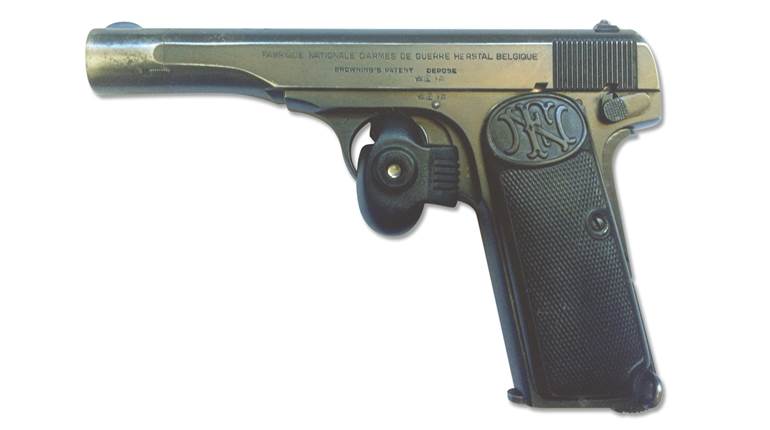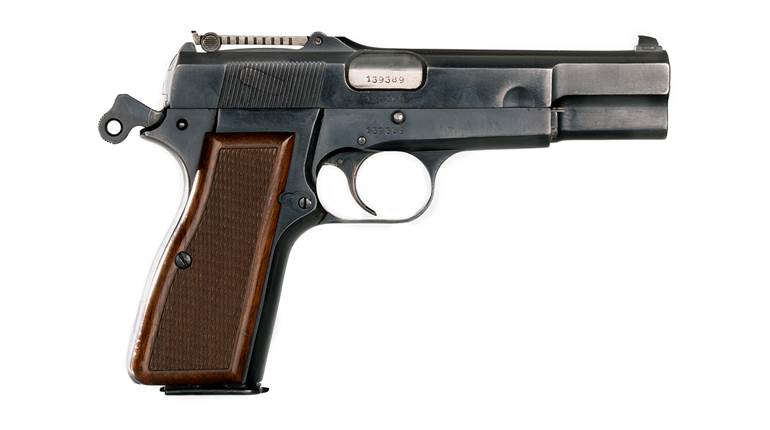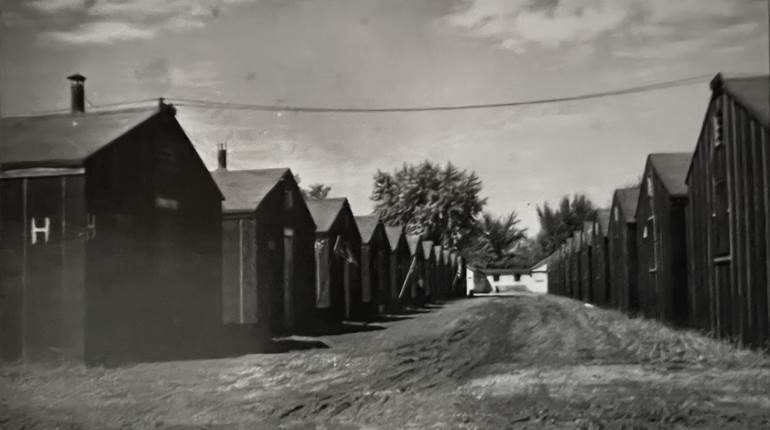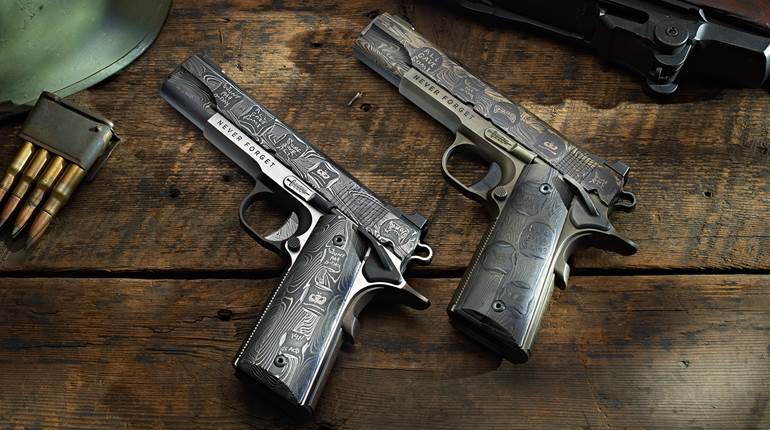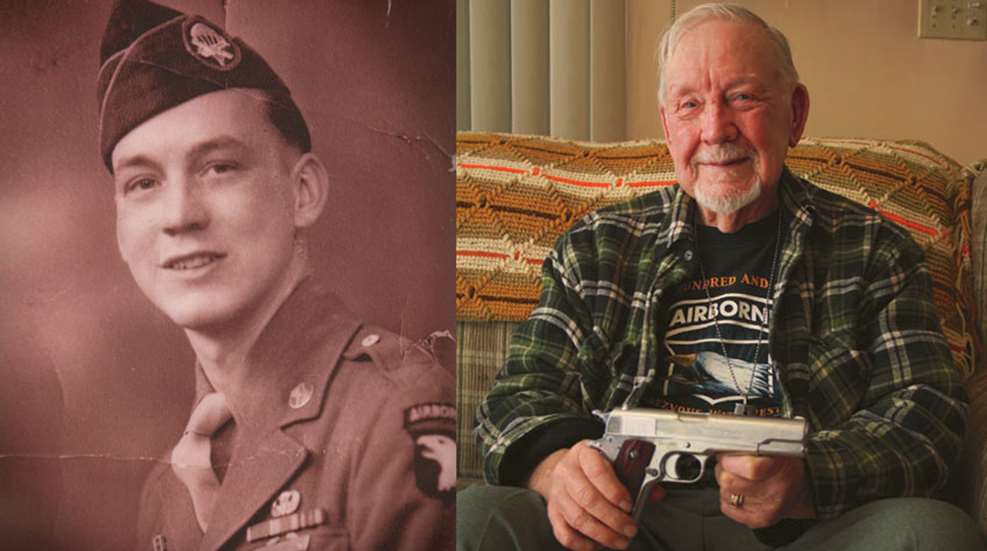
There is a broadly accepted, prevailing narrative of the American experience in the Second World War that has been familiar for many decades now. Born in the years immediately following the conclusion of the conflict, official histories from the various branches of the U.S. military established the earliest version of this narrative and provided the early structure of histories to come. But the official accounts have not achieved levels of popularity comparable to the writings of exceptional individuals who chronicled their personal experiences during the war and later published them for a popular audience. These wartime memoirs have exerted enormous influence on our understanding of the subject by reaching very large audiences, thereby creating a generation of enthusiasts who have learned about World War II through the personal recollections of those who fought it.
Undoubtedly, non-fiction books such as Guadalcanal Diary, With the Old Breed and Baa, Baa, Black Sheep have achieved great notoriety because they capture the visceral intensity of combat in the Pacific. For the war against Germany, a number of memoirs by individuals who experienced it firsthand have shaped the narrative in profound ways. Franklyn Johnson’s book One More Hill (1947) offers insight into the experience of a junior officer in the 1st Infantry Division in combat from Tunisia’s Kasserine Pass, through Sicily and on to Omaha Beach on D-Day. Charles B. Macdonald’s Company Commander: The Classic Infantry Memoir of World War II (also published in 1947) chronicles the author’s experiences as the commander of I Company, 23rd Infantry Regiment, 2nd Infantry Division. With compelling descriptions of infantry combat from the Siegfried Line, through the Battle of the Bulge, and on to the war’s end in Czechoslovakia, Company Commander remains a classic today after more than six decades. While these books brought the infantry officer’s war in Europe into sharp focus, another important dimension of the U.S. Army’s struggle to defeat National Socialist Germany remained to be written.
In 1967, one man single-handedly established the narrative of U.S. Army airborne forces fighting the European war with the publication of a single book. More than two decades before “Band of Brothers” appeared on either bookshelves or television, Donald R. Burgett’s Currahee!: A Screaming Eagle at Normandy (1967) described the experience of fighting the battle of Normandy as an American paratrooper with a clarity and frankness that quickly made it a bestseller. The gritty, no-nonsense writing style of Currahee! brings the battle of Normandy alive in a way that official histories never have—and it does so from the worm’s eye view of a 19-year-old rifleman. Mass-market paperback distribution of the book guaranteed that an entire generation of young Americans would idolize and romanticize the mighty 101st Airborne Division and its rendezvous with destiny in northern France during the summer of 1944.
While other authors had taken on the subject of the airborne before, they did so either from the perspective of the commanding heights of officer leadership or else they approached the subject broadly without managing to capture the intensity of individual combat. In contrast, Currahee! brings the battle of Normandy to life in a profoundly personal and evocative way.
One memorable passage in the book relates the story of how Burgett went about obtaining a pistol before D-Day. Concerned about not being able to get to his rifle quickly upon landing, Burgett decided that he needed a sidearm that could be brought swiftly into action on the drop zone. At the time, pistols were in short supply in England and privates were rarely able to get their hands on them. That being the case, Burgett wrote his father (a Detroit Police officer) and asked him to locate a pistol and send it to him at Aldbourne, England. Like any good father would, Officer Burgett tracked down and purchased the greatest pistol ever made—a Colt Model of 1911 .45 ACP semi-automatic that had belonged to a World War I veteran. The fact that the previous owner had the pistol nickel-plated did not stop Burgett’s father from buying it and sending it to his son in a box concealed beneath a date nut cake. When Private Burgett landed in France during the pre-dawn hours of Tuesday, June 6, 1944, the first thing he did was cock the hammer of his Colt M1911. That pistol was his constant companion during the hours that followed as he attempted to move through the “nightmarish labyrinth” of the Norman hedgerows.
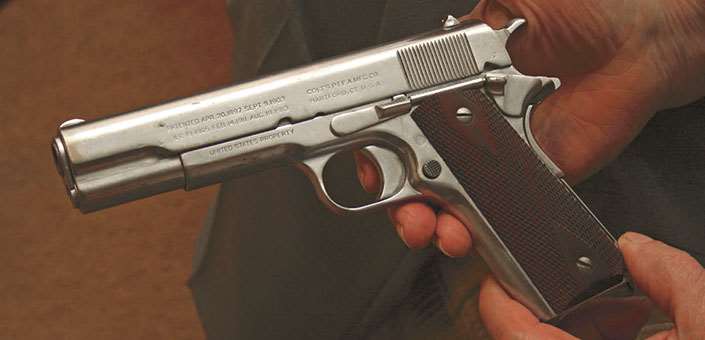
With “small private wars” being fought all around, Burgett learned quickly that it was going to be a challenge to survive D-Day. Later, he wrote in Currahee! that “It was almost impossible to tell how far away the fights were and sometimes even in what direction.” Small arms fire regularly erupted “hotter than the hinges on hell’s gates,” but Private Burgett was well-armed and ready for whatever emergency confronted him. Although he carried an M1 Garand rifle, that Colt .45 was at his side throughout this, his first campaign. He even managed to hang onto it after being seriously wounded in a bayonet charge on June 13, 1944, at a place near Carentan known as “Bloody Gulch.”
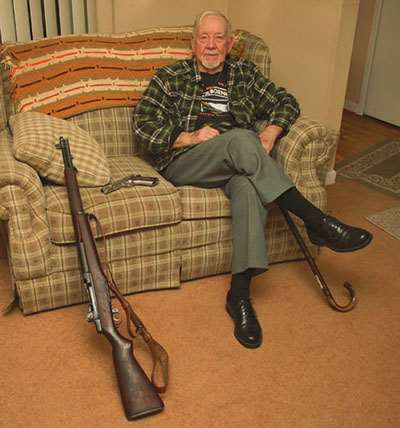
Don Burgett carried that M1911 into battle again on Sept. 17, 1944, when he jumped near the city of Eindhoven as a part of Operation Market Garden. For the next 72 days, he endured a series of unrelenting battles amid the dykes, windmills and canals of southern Holland. Just as he had with his experiences in Normandy, Burgett documented his combat in the Netherlands in a book that was published in 1999: The Road to Arnhem: A Screaming Eagle in Holland. In this book, Burgett once again captures the rawness and ferocity of front-line infantry combat in the European theater using a memoir format that swiftly achieved popularity rivaling Currahee! As if he had not been through enough already, some of the heaviest fighting Burgett would see during the war followed soon after his company—A Company, 506th Parachute Infantry—departed Holland.
In mid-December 1944, the 101st Airborne was sent to protect a strategically important crossroads town at the start of the Battle of the Bulge. The town was Bastogne in southern Belgium, and it was destined to become one of the most legendary battles in U.S. history. During the course of a week-long siege, four reinforced German fighting divisions—numbering more than 100,000 men—encircled a force of just over 10,000 Americans (from various units) and began tightening the noose. Despite the enemy’s overwhelming numerical superiority, the bitter cold temperatures and limited supplies, the men inside Bastogne’s defensive perimeter held their ground. Don Burgett was there, and so was that nickel-plated Colt .45 pistol. In fact, he found his Model of 1911 to be particularly useful in the close-quarters fighting environment of the Ardennes Forest. His book Seven Roads to Hell: A Screaming Eagle at Bastogne (also published in 1999) recounts Burgett’s experiences during that battle.
Don Burgett’s fourth book, Beyond the Rhine: A Screaming Eagle in Germany (2001), recounts the closing months of his service during World War II. Coming out of the Battle of the Bulge, he was a battle-hardened veteran ready to take on the remnants of the Third Reich. “I was nineteen years old and now had three major campaigns under my belt—I had been wounded three different times, and, in seniority, was one of the oldest of the old men.” After punching through the infamous Siegfried Line and crossing the Rhine River, the paratroopers of A Company, 506th Parachute Infantry pushed into southwest Germany’s Black Forest and then on to Bavaria. Encountering stiff resistance from pockets of Wehrmacht defenders unwilling to surrender, Burgett was involved in violent clashes of arms right up to VE-Day. When the fighting came to an end, the 101st Airborne Division was in Austria and the southernmost part of Germany near the town of Berchtesgaden.
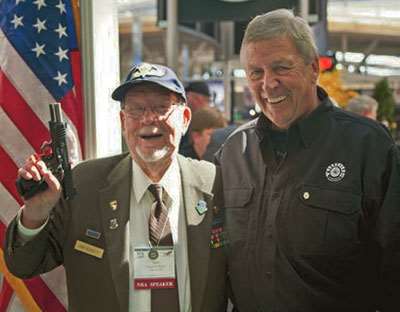
Don Burgett’s personal journey through the war in Europe had taken him from Normandy all the way to the heart of the Nazi empire at Hitler’s Eagle’s Nest. He had fought his way through four major campaigns, he had been wounded multiple times, and yet he had survived it all. He had joined the U.S. Army on his 18th birthday in April 1943, and when he received his honorable discharge on Dec. 31, 1945, the combat veteran was still not old enough to buy a beer. He returned home to Detroit in January 1946 with the Colt .45 his father had sent him at Aldbourne, England, almost two years earlier. By then, that pistol had been carried across unknown World War I battlefields only to be carried across Europe again during World War II. It fired shots in anger in Norman hedgerows, in the snow-covered woods of the Ardennes Forest, and had been used to clear bunkers of the Siegfried Line in Germany. It was holstered on Don Burgett’s hip as he explored the ruins of Adolf Hitler’s house the Berghof at Obersalzberg in May 1945.
Don Burgett is alive and well today and lives in Howell, Mich. He still owns that nickel-plated Model of 1911 and even brought it to the 140th NRA Annual Meetings and Exhibits in Pittsburgh earlier this year. In two Special Sessions, he shared stories from his four books, posed for photos with admirers and showed off the Colt .45 automatic that got him through World War II. It is a pistol with a great deal of history—but that history would be unknown were it not for the exceptional individual who owns it and can vividly recount the places it has been.
Don Burgett & “An Eagle Returns”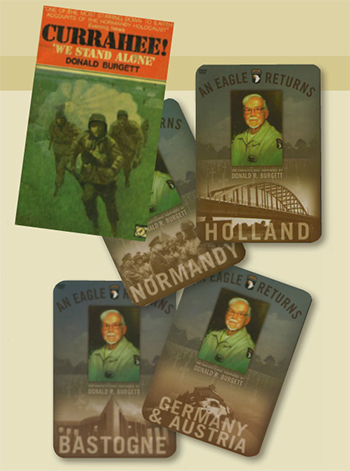 When Don Burgett’s first book Currahee!: A Screaming Eagle at Normandy came out in 1967, it was before the Tet Offensive, the My Lai Massacre, the Invasion of Cambodia and Kent State. The United States was a different nation then—one that still celebrated its contribution to victory in World War II and the people who made that victory possible. But the way the United States viewed its military was about to undergo a fundamental change. During the pivotal years of ’68, ’69 and ’70, the academic establishment, which had never before been particularly adverse to the military, abandoned it in critique of Vietnam policy. Yale University expelled its ROTC battalion from campus, Jane Fonda visited Hanoi, and a counterculture was born that lashed out at all things military. This era of high-minded idealism turned a cynical eye toward the political realities of the Cold War and regarded the policies of intervention and containment with deep pessimism. It was the end of the victory culture in the United States.
When Don Burgett’s first book Currahee!: A Screaming Eagle at Normandy came out in 1967, it was before the Tet Offensive, the My Lai Massacre, the Invasion of Cambodia and Kent State. The United States was a different nation then—one that still celebrated its contribution to victory in World War II and the people who made that victory possible. But the way the United States viewed its military was about to undergo a fundamental change. During the pivotal years of ’68, ’69 and ’70, the academic establishment, which had never before been particularly adverse to the military, abandoned it in critique of Vietnam policy. Yale University expelled its ROTC battalion from campus, Jane Fonda visited Hanoi, and a counterculture was born that lashed out at all things military. This era of high-minded idealism turned a cynical eye toward the political realities of the Cold War and regarded the policies of intervention and containment with deep pessimism. It was the end of the victory culture in the United States.
Although President Nixon reached out to a “silent majority” of Americans for support in November 1969, the damage had already been done, and the military was suddenly remarkably unpopular. A wave of anti-war/anti-military sentiment swept over the national body politic, engulfi ng the world of popular media—including the country’s mass-market publishing houses. Not surprisingly, the company that had welcomed the opportunity to publish Currahee! in 1967 declined a proposal for a follow-up book in 1968. It is for that reason more than three decades passed before the release of Don Burgett’s second memoir, The Road to Arnhem: A Screaming Eagle in Holland, in 1999. During that 32 years, Burgett raised a family, built a house (the one he still lives in by the way), completed his high school diploma and paid his taxes. Also during that 32 years, the United States underwent another fundamental transformation. With the abandonment of Vietnam, national confidence sank to a new low after 1975. An end to the Cold War was nowhere in sight, and the Iranian Hostage Crisis in 1979 made the United States seem weak. Then, in 1984, President Reagan visited Normandy to observe the 40th anniversary of D-Day. His much-publicized appearance marked a reawakening of the impulse to celebrate victory over fascism, imperialism and totalitarianism. After 15 years of highly politicized indifference, the country began to memorialize the Second World War again. Suddenly, monuments were being built, movies and mini-series were being produced and the print world came alive once again with books examining the Second World War.
Under these fundamentally changed circumstances, a reprint edition of Currahee! was published in 1999, and Burgett was able to get three more books published as fast as he could write them: The Road to Arnhem: A Screaming Eagle in Holland; and Seven Roads to Hell: A Screaming Eagle at Bastogne in 1999; and Beyond the Rhine: A Screaming Eagle in Germany in 2001. Contrary to popular opinion though, writing non-fiction is not a fast track to wealth—something that Burgett knows all too well from experience. Although he was compensated for each published manuscript, he long ago signed away his rights to the reprint editions that appear on the shelves of every major book retailer in North America. The result is that Don Burgett may be a well-known man, but he is certainly not a rich one. Since his royalties from the books have dwindled to practically nothing, he has attempted to produce a little bit of income with a website—www.donaldrburgett.com— where you can read his biography, view a photo gallery and even join the official Don Burgett Fan Club.
On the website, you can also purchase a copy of “An Eagle Returns”—a video series that was recorded in 2006 when Burgett returned to the European battlefi elds where he fought as a young man. In England, France, Holland, Belgium, Austria and Germany, he recalls his memories of war on the exact spots where it all happened in 1944/1945. Each of the four DVDs of “An Eagle Returns” can be purchased separately or in a handsomely packaged box set. Don Burgett will even autograph the set for you. Thus for the small sum of $50 (plus shipping), you can watch one of the legends of the 101st Airborne recall his combat experiences from Carentan to Hitler’s Eagle’s Nest. The best part is that every penny goes directly to Don Burgett—a man who was willing to give his country everything but never expected anything in return—a man who waited patiently for more than 30 years for the nation to listen to him again.
—Martin K.A. Morgan
Additional Reading:
Video: American Rifleman TV: Don Burgett, Part 1
Video: American Rifleman TV: Don Burgett, Part 2












